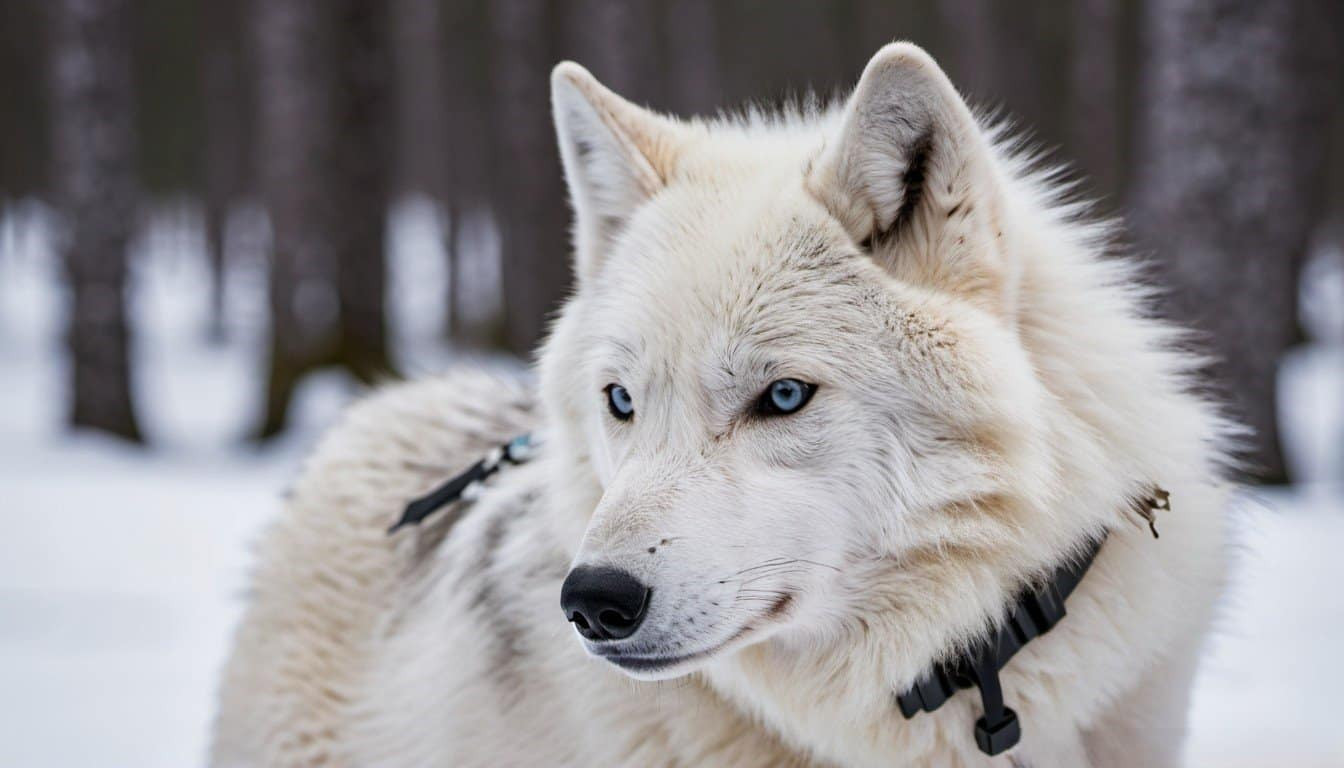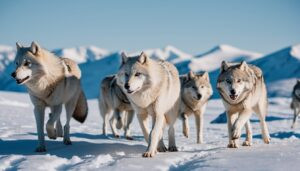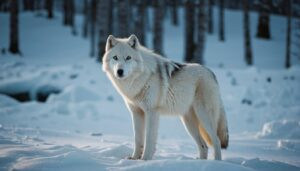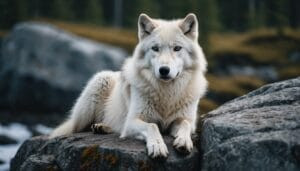Introduction
Understanding Arctic wolf populations is crucial for conservation efforts and ecological studies. This article explores the various techniques and technologies used to monitor and study these elusive creatures
We will delve into tracking and monitoring methods, data collection techniques, environmental and human impacts, challenges faced by researchers, and recent findings on Arctic wolf behavior
Tracking and Monitoring Techniques
Tracking and monitoring Arctic wolf populations require sophisticated methods to ensure accurate data collection while minimizing disruption to the wolves’ natural behaviors. Researchers utilize various techniques, including GPS collars, radio telemetry, and advanced imaging technologies like drones and satellites
GPS Collars
One of the most effective methods for tracking Arctic wolves is the use of GPS collars. These collars are designed to fit securely around the wolf’s neck, equipped with GPS devices that transmit location data at regular intervals. This data provides invaluable insights into the wolves’ movement patterns, territorial ranges, and migration routes
The process of collaring a wolf involves tranquilizing the animal using a dart gun from a safe distance
Once the wolf is sedated, researchers quickly and carefully fit the collar, ensuring it is neither too tight nor too loose. After the wolf wakes up, it resumes its normal activities, largely unaffected by the collar
Data collected from GPS collars is analyzed to identify key areas that are critical to the wolves’ survival, such as hunting grounds, denning sites, and travel corridors. This information helps conservationists develop strategies to protect these vital habitats
Radio Telemetry
Before the advent of GPS technology, radio telemetry was the primary method for tracking wildlife, including Arctic wolves. Although less precise than GPS, radio telemetry remains a valuable tool in wildlife research
This method involves fitting the wolves with radio collars that emit signals detectable by a receiver
Researchers track the radio signals by manually following the beeps using directional antennas. This technique requires fieldwork, often in harsh and remote conditions. While radio telemetry does not provide the same level of detail as GPS, it is useful for short-term studies and situations where GPS technology may not be feasible
Radio telemetry helps researchers monitor the general location and movement of the wolves, allowing them to observe behavioral patterns and interactions within the pack. The data collected also supports long-term studies on population dynamics and ecological impacts
Drones and Satellite Imaging
In recent years, drones and satellite imaging have revolutionized wildlife monitoring. Drones equipped with high-resolution cameras and thermal imaging capabilities allow researchers to observe Arctic wolves from a distance without disturbing them
Drones can cover large areas quickly, capturing real-time footage and providing a bird’s-eye view of the wolves’ activities
Satellite imaging complements drone technology by offering broader geographic coverage. Satellites can track large-scale movements and habitat changes over time. This combination of drone and satellite technology enables researchers to gather comprehensive data on Arctic wolf populations and their environments
Drones are particularly useful for studying wolves in hard-to-reach areas, such as mountainous terrains and vast tundra regions. They help in locating packs, identifying individual wolves, and observing interactions within the pack
This non-invasive method minimizes the stress on the animals and provides accurate, high-resolution data
Data Collection Methods
Accurate data collection is vital for understanding Arctic wolf populations and their behaviors. Researchers employ a variety of methods, including field observations, camera traps, and sample collection, to gather comprehensive information on these elusive creatures
Field Observations
Field observations are a fundamental aspect of studying Arctic wolves. Researchers spend extensive periods in the wolves’ natural habitat, observing their behaviors, social structures, and interactions. This method provides firsthand insights into the daily lives of the wolves, including their hunting strategies, mating rituals, and pack dynamics
Field researchers often use binoculars and spotting scopes to observe wolves from a distance, ensuring they do not disturb the animals. They meticulously record their findings in field journals, noting details such as the wolves’ locations, activities, and any notable behaviors
These observations are crucial for developing a thorough understanding of the species
One of the challenges of field observations is the harsh Arctic environment. Researchers must be well-prepared for extreme weather conditions and have the endurance to spend long hours in the field
Despite these challenges, the data gathered through direct observation is invaluable for studying wolf behavior and ecology
Camera Traps
Camera traps are an effective tool for monitoring Arctic wolves, especially in remote or difficult-to-access areas. These devices are strategically placed in locations frequented by wolves, such as trails, den sites, and hunting grounds
Equipped with motion sensors, camera traps automatically capture images or videos when an animal passes by
The use of camera traps allows researchers to collect continuous data without being physically present, reducing the likelihood of disturbing the wolves. The images and videos provide visual evidence of the wolves’ presence, behaviors, and interactions with other wildlife
Camera traps also help identify individual wolves through unique markings and characteristics. This information is crucial for tracking population size, pack composition, and movements
Additionally, camera traps can capture rare or elusive behaviors that might be missed during field observations
Sample Collection
Collecting biological samples is another essential method for studying Arctic wolves. Researchers gather samples such as fur, feces, and blood to analyze genetic information, diet, health, and hormone levels
These samples provide a wealth of information that cannot be obtained through observation alone
Genetic analysis of fur and blood samples helps identify individual wolves and understand their genetic diversity. This information is vital for assessing the health and viability of the population
Fecal samples reveal insights into the wolves’ diet, parasite load, and stress levels, offering a comprehensive picture of their overall health and well-being
Collecting samples in the field requires careful handling and preservation to ensure the integrity of the data. Researchers often use gloves and sterile tools to prevent contamination. The samples are then transported to laboratories for detailed analysis
Environmental and Human Impacts
The Arctic wolf’s environment is both harsh and dynamic, and various factors, including climate change and human activities, significantly impact their populations. Understanding these impacts is crucial for developing effective conservation strategies
Climate Change
Climate change poses one of the most significant threats to Arctic wolf populations. Rising temperatures and shifting weather patterns affect the availability of prey, alter habitat conditions, and disrupt the delicate balance of the Arctic ecosystem
One major impact of climate change is the alteration of prey populations. For instance, changes in the distribution and abundance of caribou, a primary food source for Arctic wolves, can lead to food scarcity. As prey species migrate or decline in numbers, wolves may struggle to find sufficient food, leading to decreased survival rates and lower reproductive success
Melting ice and permafrost also impact the wolves’ habitat. As the Arctic ice melts, wolves lose crucial hunting grounds and travel routes. The changing landscape can also lead to increased competition with other predators, such as polar bears, for the same dwindling resources
Researchers monitor these changes by tracking weather patterns, studying prey populations, and observing shifts in wolf behavior. This data helps predict how Arctic wolf populations might adapt or struggle in response to ongoing climate changes, informing conservation efforts
Human Activities
Human activities, including industrial development and tourism, also impact Arctic wolf populations. The expansion of oil and gas exploration, mining operations, and infrastructure projects can lead to habitat destruction and fragmentation, disrupting the wolves’ natural territories and migration routes
Increased human presence in the Arctic can lead to direct and indirect disturbances. Noise from machinery, vehicles, and human activities can drive wolves away from critical areas, such as den sites and hunting grounds
Additionally, pollution from industrial activities can contaminate the environment, affecting both the wolves and their prey
Tourism, while beneficial for raising awareness about Arctic wildlife, can also pose risks if not managed properly. Human-wolf interactions, even when unintentional, can lead to habituation, where wolves become accustomed to human presence
This can result in dangerous encounters and increased vulnerability to poaching
Conservationists work to mitigate these impacts by advocating for responsible development practices, establishing protected areas, and implementing regulations to limit human disturbance. Education and outreach programs aim to raise awareness about the importance of preserving Arctic ecosystems and the species that inhabit them
Challenges in Studying Arctic Wolves
Studying Arctic wolves presents numerous challenges due to the extreme environment and the wolves’ elusive nature. Researchers must contend with harsh weather conditions and remote locations to gather accurate data
Harsh Weather Conditions
The Arctic is known for its extreme weather, with temperatures plunging well below freezing, powerful winds, and frequent snowstorms. These harsh conditions make fieldwork challenging and can pose serious risks to researchers. Hypothermia, frostbite, and limited visibility are constant concerns that can hinder data collection efforts
Weather conditions also affect the wolves themselves. During severe weather, wolves may alter their behavior, seek shelter, and become less active, making them harder to observe
Researchers must be adaptable and prepared to spend extended periods in the field, often waiting for suitable weather conditions to conduct their studies
To mitigate these challenges, researchers use specialized equipment and clothing designed for Arctic conditions. Portable shelters and heaters can provide temporary relief from the cold, allowing researchers to continue their work in adverse weather
Advanced technology, such as remote sensing and automated data collection devices, can also reduce the need for constant human presence in the field
Remote Locations
Arctic wolves inhabit some of the most remote and inaccessible regions on Earth. These areas often lack infrastructure, making it difficult for researchers to travel to and conduct long-term studies. The logistics of transporting equipment, supplies, and personnel to these remote locations can be complex and costly
The remoteness of the Arctic also means limited access to communication and medical facilities. Researchers must be self-sufficient, carrying all necessary supplies and emergency equipment. Satellite phones and GPS devices are essential for maintaining contact with support teams and ensuring safety
The isolation can also impact the mental and physical well-being of researchers. Extended periods in remote locations with limited social interaction and the constant need for vigilance can lead to fatigue and stress
Team members must be well-prepared and trained to handle the unique challenges of Arctic fieldwork
Despite these difficulties, the remoteness of the Arctic offers an unspoiled environment for studying natural wolf behavior. The lack of human disturbance allows researchers to observe wolves in their natural state, providing valuable insights into their ecology and behavior
Insights from Recent Studies
Recent studies have provided valuable insights into the behavior, social structures, and hunting patterns of Arctic wolves. These findings enhance our understanding of how these predators adapt to their harsh environment and interact within their packs
Pack Dynamics
Arctic wolves are highly social animals that live and hunt in packs. Recent research has shed light on the complex social structures within these packs, revealing a hierarchy that influences behavior and interactions
Typically, a dominant alpha male and female lead the pack, making critical decisions related to hunting and territory
Studies have shown that pack size can vary, often depending on the availability of prey and environmental conditions. Larger packs may form during times of abundant prey, while smaller packs or even solitary wolves may be observed when food is scarce
The pack structure is essential for cooperative hunting, as it allows wolves to take down larger prey that would be impossible for a lone wolf to tackle
Communication within the pack is crucial for maintaining social bonds and coordinating activities. Wolves use vocalizations, body language, and scent marking to convey messages
Howls, for example, can serve to assemble the pack, communicate location, or ward off rival packs. Understanding these communication methods helps researchers interpret wolf behavior and social interactions
Hunting Patterns
Hunting is a critical aspect of Arctic wolf survival, and recent studies have provided detailed insights into their hunting strategies and prey preferences
Arctic wolves primarily hunt large ungulates, such as caribou and muskoxen, but their diet can also include smaller mammals, birds, and even fish during certain times of the year
Research has shown that Arctic wolves employ a variety of hunting techniques depending on the prey and environmental conditions. For instance, when hunting caribou, wolves may use endurance strategies, chasing their prey over long distances to exhaust it
In contrast, hunting muskoxen often involves coordinated attacks to isolate and take down an individual from the herd
Seasonal changes also influence hunting patterns. During the winter, when prey is scarcer and more challenging to catch, wolves may travel greater distances and hunt more frequently to meet their nutritional needs. The summer months, with more abundant prey, allow wolves to focus on raising pups and teaching them essential hunting skills
Studies using GPS collars and camera traps have provided detailed data on hunting events, revealing patterns in prey selection and kill rates. This information is vital for understanding the ecological role of Arctic wolves and their impact on prey populations
Conclusion
Understanding and monitoring Arctic wolf populations is essential for ensuring their conservation and the health of Arctic ecosystems
This article has explored various aspects of studying these elusive creatures, highlighting the methods and technologies used by researchers, the environmental and human impacts on their populations, the challenges faced in the field, and the valuable insights gained from recent studies
Researchers employ sophisticated tracking and monitoring techniques such as GPS collars, radio telemetry, and drones to gather accurate data on Arctic wolves. Data collection methods, including field observations, camera traps, and sample collection, provide comprehensive information on wolf behavior and health
The impacts of climate change and human activities pose significant threats to Arctic wolves, but ongoing conservation efforts aim to mitigate these effects
Fieldwork in the Arctic presents unique challenges due to harsh weather conditions and remote locations. Despite these difficulties, dedicated researchers continue to uncover important findings about Arctic wolf pack dynamics and hunting patterns
These insights enhance our understanding of how these predators adapt to their environment and interact within their ecosystems
By combining advanced technology with traditional field methods, researchers strive to protect Arctic wolf populations and ensure their survival in a rapidly changing world. The knowledge gained from these studies informs conservation strategies and helps preserve the delicate balance of the Arctic ecosystem for future generations










